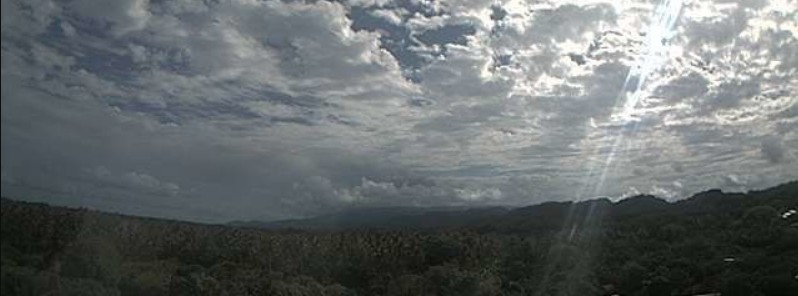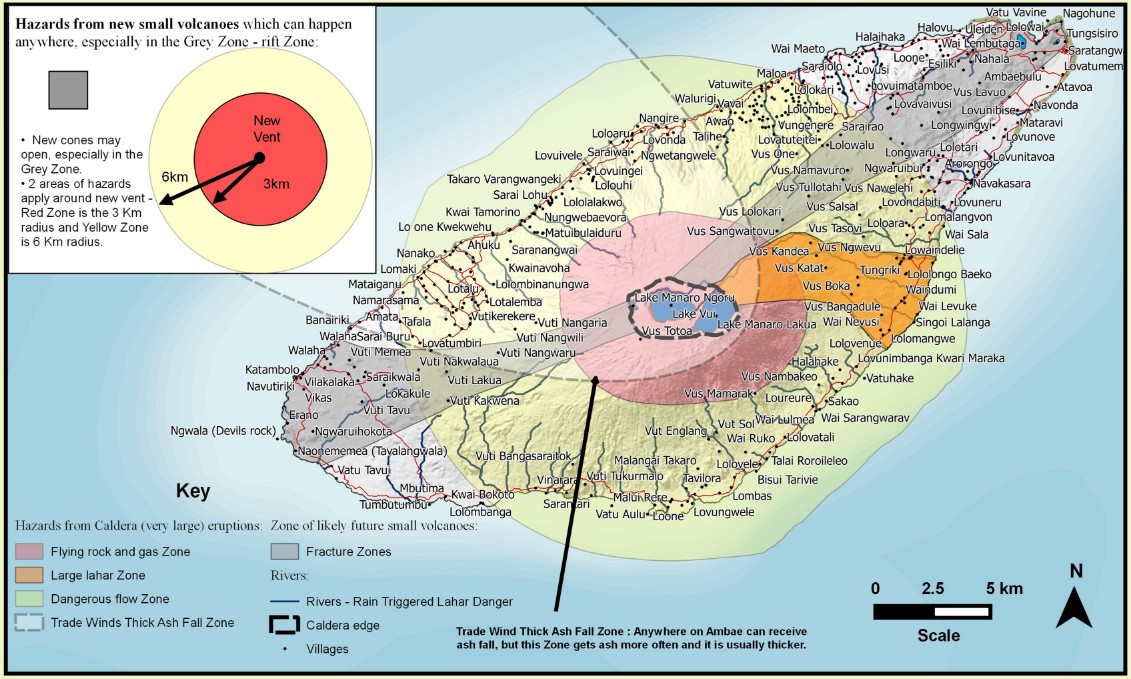Alert level for Aoba (Ambae) volcano raised to second highest, Vanuatu

The Alert Level for Aoba volcano, also known as Ambae, was raised to the second highest (4 of 5) on Saturday, September 23, 2017.
The activity at the volcano gradually intensified over the past couple of weeks and continues to intensify. The activity forced authorities to raise the Alert Level from 2 to 3 on September 6, and to Level 4 on September 23.
"This [Level 4] means that the Ambae volcano is in a moderate eruption state," the Vanuatu Meteorology and Geohazards Department said in a Bulletin N°11 for Ambae volcano issued September 23, 2017.
"At this Alert Level, the volcanic activity is likely to continue to increase or decrease to its normal level of unrest at any time," it added.
The danger is in the Red, Grey, Orange and White dotted Zones, marked on the map below:

For a larger version, including volcanic hazards and what do to in case of eruption, click here.
With this situation, flying rocks and volcanic gas will affect the Red Zone which is about 6.5 km (4 miles) radius from Manaro Voui.
Villages located in the Grey and Orange Zone will expect unusual volcanic hazards and ash falls can be expected around the island especially in villages exposed to prevailing trade winds direction, White Zone dotted. Acid rain may also be expected in that zone. Acid rain cause foliage fumigation hence damage garden crops.
"It’s very important that authorities, communities, villages, visitors and travel agencies seriously consider this information," the observatory warned.
According to Volcano Discovery, a vent in or near the caldera lake Voui has been producing mild ash emissions over the past weeks, but these have now become stronger and for the first time lava glow also was observed, suggesting that the eruption is transitioning from phreatic (steam-driven) to magmatic (arrival of fresh magma).
Authorities in Vanuatu are preparing to evacuate up to 5 000 people from the island's most exposed areas to safer locations, local media reproted.
"In the early hours, around 3-4am, we noticed that the activity started to increase, followed by another eruptive phase," Ms Esline Garaeviti, the manager of the Geohazards Department, was quoted on Radio New Zealand.
"So the ash plume from Ambae is still there now. The ash fall is expected all around the island."
"The increased level of activity means increased area of risk," she said. "There's more risk exposed to people on the island, that's why. It's a moderate state of activity."
The current state of the eruption was only moderate with explosions at the crater generating small ash plumes, but it could become larger and directly threaten people living in areas closest to the volcano, in particular those north and south of the summit and areas near or in valleys draining from the caldera lake. Safer locations would include eastern and western parts of Ambae.
The last known eruption of this volcano took place in 2011. However, the last significant activity was in 2005, when a similar evacuation was done and forced people to leave their villages for 3 months.
Geological summary
Aoba, also known as Ambae, is a massive 2 500 km3 (600 mi3) basaltic shield volcano that is the most voluminous volcano of the New Hebrides archipelago. A pronounced NE-SW-trending rift zone dotted with scoria cones gives the 16 x 38 km (10 x 23.6 miles) island an elongated form.
A broad pyroclastic cone containing three crater lakes is located at the summit of the Hawaiian-style shield volcano within the youngest of at least two nested calderas, the largest of which is 6 km (3.7 miles) in diameter. Post-caldera explosive eruptions formed the summit craters of Lake Voui (also spelled Vui) and Lake Manaro Ngoru about 360 years ago. A tuff cone was constructed within Lake Voui about 60 years later.
The latest known flank eruption, about 300 years ago, destroyed the population of the Nduindui area near the western coast. (GVP)
Featured image: Aoba (Ambae) volcano on September 23, 2017. Credit: Vanuatu Meteorology and Geohazards Department

Commenting rules and guidelines
We value the thoughts and opinions of our readers and welcome healthy discussions on our website. In order to maintain a respectful and positive community, we ask that all commenters follow these rules.